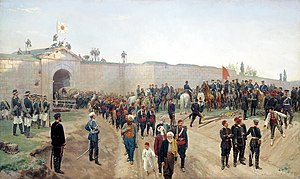Battle of Nikopol (1877)
| date | July 16, 1877 |
|---|---|
| place | Nikopol , Ottoman Empire , today Bulgaria |
| output | Russian victory |
| Territorial changes | Northern Bulgaria |
| consequences | Advance of the Russians to Pleven |
| Parties to the conflict | |
|---|---|
| Commander | |
|
Nikolai von Krüdener |
|
| Troop strength | |
| Russian IX Corps: 18 battalions of infantry 23 squadrons of cavalry 92 guns total 20,000 |
10 battalions infantry 8,500 |
| losses | |
|
276 dead |
7,000 prisoners |
Zimnicea - Nikopol - 1st Shipka Pass - Elena - 2nd Shipka Pass - Pleven - Lovech - 3rd Shipka Pass - Kızıl Tepe - Alaja - Gorni-Dubnik - Kars - Tashkesen - 4th Shipka Pass - Plovdiv
The Battle of Nikopol was one of the first battles of the Russo-Ottoman War of 1877.
prehistory
The immediate trigger of the war was the Ottoman repression against the Serbs and the Bulgarians after the Serbian-Ottoman War in 1876 and the Bulgarian April Uprising of 1877. This was preceded by the Danube crossing at Swishtow on June 26, 1877 . The Russian army under Grand Duke Nikolai Nikolaevich had the Danube near the town of Svishtov with rowing boats and barges crossed. After the fall of Svishtov, the attack swung westwards to Nikopol, 50 km away.
course
By order of July 9th, the mass of the Russian IX. Army corps under Lieutenant General Baron Nikolai von Krüdener transferred the march to the west to take the fortress Nikopol. For this task were provided:
- 5th Infantry Division (Lieutenant General von Schilder-Schuldner )
- 31st Infantry Division (General Veljaminov)
- 9th Cavalry Division (Major General Loskarew)
- Caucasus Cossack Brigade (Colonel Tutolmin),
- the Caucasus Cossack Brigade,
- as well as 2 sotnias of the 34th Cossack Regiment with a total of about 18 battalions, 23 squadrons and 92 guns with about 20,000 men.
On July 11th, the 9th Cavalry Division (9th Uhlanen and 9th Cossack regimes, 2nd Cossack battery) was turned south against the Vid line in order to scout in the direction of Plewna , while Krüdener with the two infantry Divisions continued to take action against Nikopol. On the morning of July 15, the bombardment began against the fortress and was only moderately replied by Hassan Hairi Pascha, the commander of the Turkish garrison, with around 8,500 men and 113 fortress guns. On the left bank of the Osma, on the heights between the Osma and the Vid, the Turkish troops were with their main focus at Gradesti. The Russian artillery was supported by allied Romanian batteries from Turnu Măgurele (Flamanda), which had already started sporadic bombardment on June 25th. On the right wing from Belinaturska, the Krüdener column, on the left wing General Loskarew and the 20th Infantry Regiment attacked the fortress from Vubla. At Debowa, General Schilder-Schuldner's column with the 1st Brigade of the 5th Infantry Division concentrated on the main attack. The Russian attacks northward between the Osma and the Vid were able to secure the crossings over the Osma and force the Turkish defenses on the left bank of this river into the fortress. Several Russian assaults followed. In the evening, General Veljaminov's column (31st Infantry Division) reached the eastern redoubts of Nikopol and began to encircle them.
At dawn of the following day (July 16), when the Russian troops had already started the assault, the defenders hoisted the white flag on the ramparts of the fortress. The Turkish parliamentary sent to Krüdener's headquarters initially insisted on allowing the garrison to withdraw freely, but soon had to accept the Russian demand for unconditional surrender. At 5 p.m. the crew stretched out their weapons in front of the east gate and marched into captivity. Major General Arkady Dmitrievich Stolypin (1821-1899) was appointed commander of the Nikopol Fortress.
consequences
The Ottoman garrison in Nikopol requested reinforcements from the Baba Vida fortress in Vidin too late . This relief had already been proposed several times by Osman Pascha to the high command in Istanbul, since the Vidin Army was in an isolated position on the border with Serbia anyway with 30,000 men. When this project was finally approved on July 11th, it was already too late to arrive in time for the fall of the city. A crew of 13 battalions remained in Vidin under the command of Mehmed Izzet Pasha, while Osman Pasha moved with the main force to the nearby city of Pleven . The siege of Pleven followed .
See also
literature
- Genov Tsonko, Liberation War 1877–1878, published "Wissenschaft und Kunst", Sofia, 1978, pp. 100–102.
- George Georgiev, War of Liberation 1877-1878, Encyclopedia Reference CI "P.Beron", Sofia, 1986, pp. 52, 112-113.
- Thilo von Trotha, The Battle for Plevna - Tactical Studies, Berlin 1878.
Web links
- The battle of Nikopol. Radio Bulgaria, September 25, 2007, accessed October 3, 2007 .
- http://www.xenophongi.org/rushistory/battles/plevna2.htm
- Compton's Home Library: Battles of the World CD-ROM
